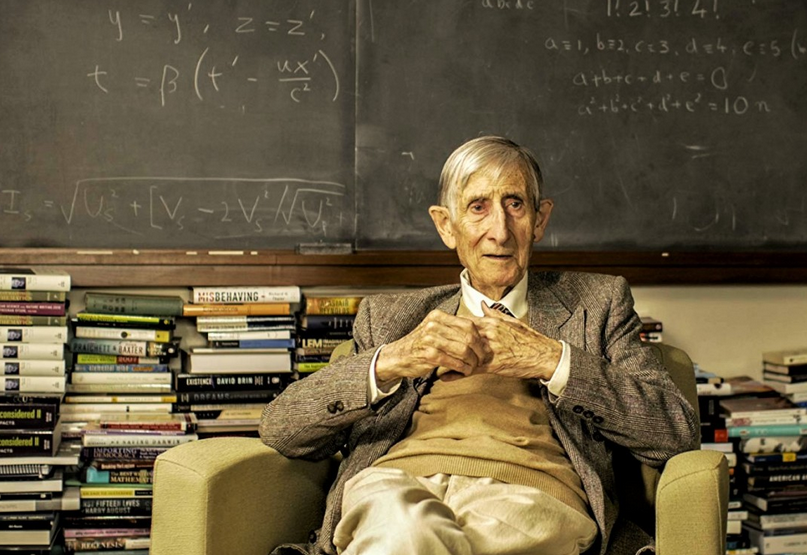
The McCarthy multimatrix ensemble of random matrices. For all integers $n\geq1$ and $d\geq1$, let $\mathbb{M}_{n,d}$ be the set of $d$-tuples $(M_1,\ldots,M_d)$ of $n\times n$ Hermitian matrices such that
\[
M_pM_q=M_qM_p\quad\text{for all $1\leq p,q\leq d$.}
\] We equip this hypersurface with the trace of the Gaussian distribution, namely
\[
(M_1,\ldots,M_d)
\mapsto\frac{1}{Z_{n,d}}
\mathrm{e}^{-\sum_{k=1}^d\mathrm{Tr}(M_k^2)}\mathrm{d}M
\] where $\mathrm{d}M$ is the trace on $\mathbb{M}_{n,d}$ of the (product) Lebesgue measure on $d$-uples of $n\times n$ Hermitian matrices, and $Z_{n,d}$ is the normalizing constant. Since the Hermitian matrices $M_1,\ldots,M_d$ commute, they are diagonalizable in the same orthonormal basis, namely there exists a single $n\times n$ unitary matrix $U$ and real $n\times n$ diagonal matrices $D_1,\ldots,D_d$ carrying the eigenvalues of $M_1,\ldots,M_d$ respectively such that
\[
U(M_1,\ldots,M_d)U^*
=(D_1,\ldots,D_d).
\] The eigenvectors couple the eigenvalues : $\lambda_i\in\mathbb{R}^d$ is an eigenvalue of $(M_1,\ldots,M_d)$ when there exists $u\in\mathbb{R}^n$, $u\neq0$, such that $M_pu=\lambda_{i,p}u$ for all $1\leq p\leq n$. The computation of the Jacobbian of the spectral change of variable provides the following remarkable fact: the joint law of the eigenvalues $\lambda_1,\ldots,\lambda_n$ of $(M_1,\ldots,M_d)$ has probability density function
\[
(\lambda_1,\ldots,\lambda_n)\in(\mathbb{R}^d)^n
\mapsto\frac{1}{Z_{n,d}}
\mathrm{e}^{-\sum_{i=1}^n\|\lambda_i\|^2}
\prod_{1\leq i< j\leq n}\|\lambda_i-\lambda_j\|^2
\mathrm{d}\lambda
\] where $\mathrm{d}\lambda$ is the Lebesgue measure on $(\mathbb{R}^d)^n$, $\|x\|^2:=x_1^2+\cdots+x_d^2$ is the squared Euclidean norm of $\mathbb{R}^d$, and $Z_{n,d}$ is the normalizing constant. When $d=1$, we recover the usual formula for the Gaussian Unitary Ensemble (GUE), studied notably by Freeman Dyson. Thus the model generalizes the GUE into a ``MacCarthy Unitary Ensemble'' (MUE). When $d=2$, we obtain the formula for the spectrum of the complex Ginibre ensemble, providing a novel interpretation of this formula in terms of spectrum of two commuting Hermitian matrices!
The log-gas picture and the analogue of the Wigner theorem. The law above is a log-gas of $n$ particles on $\mathbb{R}^d$ with quadratic external field, namely
\[
\mathrm{e}^{-\sum_{i=1}^n\|\lambda_i\|^2}
\prod_{1\leq i< j\leq n}\|\lambda_i-\lambda_j\|^2
=\exp\Bigr(n\int V\mathrm{d}\mu_n+\iint_{\neq}W\mathrm{d}\mu_n^{\otimes 2}\Bigr)
\] where
\[
V(x):=\|x\|^2,\quad
W(x,y):=\log\frac{1}{\|x-y\|},\quad
\mu_n:=\frac{1}{n}\sum_{i=1}^n\delta_{\lambda_i}.
\] What is the behavior of the empirical measure $\mu_n$ under this law? By computing the correlation functions, or by using the Laplace method, we get that after scaling by $n^{-1/2}$, the empirical measure in high dimension $n$ tends to the equilibrium measure
\[
\mu_{\mathrm{eq}}
=\arg\min_\mu\Bigr(\int V\mathrm{d}\mu+\iint W\mathrm{d}\mu^{\otimes 2}\Bigr)
\] where the minimum runs over the set of probability measures on $\mathbb{R}^d$. It turns out that these equibrium measures were already computed, quite recently for $d\geq3$, namely
\[
\mu_{\mathrm{eq}}
=
\begin{cases}
\frac{1}{\pi} \sqrt{2-x^2} \mathbf{1}_{|x|\leq\sqrt{2}}
& \text{if $d=1$}\\
\frac{1}{\pi} \mathbf{1}_{\|x\|\leq1}
& \text{if $d=2$}\\
\frac{3}{2\pi^2}\frac{1}{\sqrt{\frac{2}{3}-\|x\|^2}}\mathbf{1}_{\|x\|\leq\sqrt{\frac{2}{3}}}
&\text{if $d=3$}\\
\sigma_{S^{d-1}(\frac{1}{\sqrt{2}})}
& \text{if $d\geq 4$}
\end{cases}
\] where $\sigma_{S^{d-1}(R)}$ is the uniform distribution on the sphere $S^{d-1}:=\{x\in\mathbb{R}^d:\|x\|=R\}$ of radius $R$. Also $\mu_{\mathrm{eq}}$ is radially symmetric and its one-dimensional projections are semi-circle distributions. We have an analogue or generalization of the Wigner theorem for the McCarthy multimatrix Ensemble. The Wigner theorem for GUE corresponds to $d=1$.
Note. Lydia Giacomin is studying these questions as a side project during her PhD.
Further reading.
- John E. McCarthy
Random commuting matrices
Preprint (2023) - John E. McCarthy and Hazel T. McCarthy
Random anti-commuting Hermitian matrices
Preprint (2023) - Peter Elbau and Giovanni Felder
Density of eigenvalues of random normal matrices
Communications in Mathematical Physis (2005) - Djalil Chafai, Edward B. Saff, and Robert S. Womersley
On the solution of a Riesz equilibrium problem and integral identities for special functions
Journal of Mathematical Analysis and Applications (2022) - Djalil Chafai, Edward B. Saff, and Robert S. Womersley
Threshold condensation to singular support for a Riesz equilibrium problem
Analysis and Mathematical Physics (2023) - Peter J. Forrester
Log-Gases and Random Matrices
London Mathematical Society Monographs, Princeton University Press (2010)
